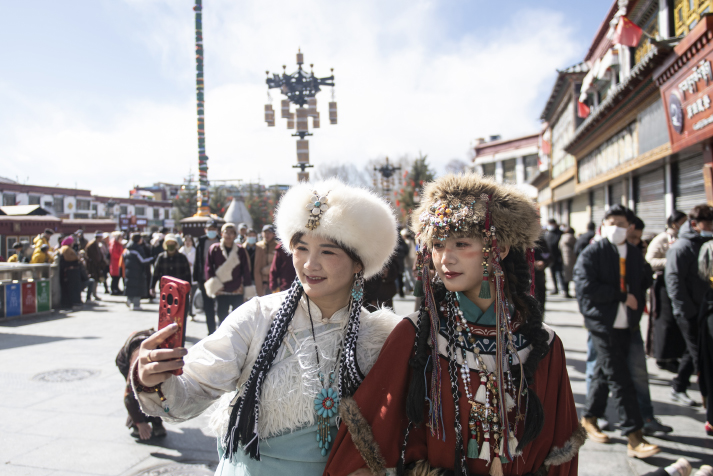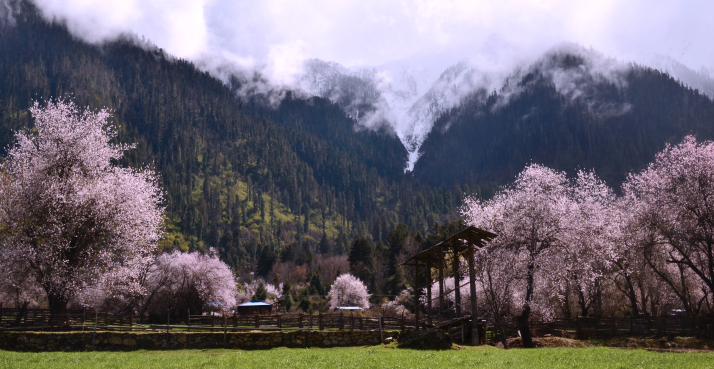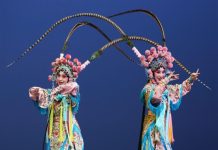In March, driving along the Nyingchi section of National Highway 318, also known as the Sichuan-Xizang Highway, visitors can see that while the mountains afar are still covered with snow, peach trees are already in full blossom.
A sea of peach trees in flower interspersed among villages and green wheat fields creates a spectacle against the backdrop of snow-capped mountains, glistening glaciers and meandering river valleys in Nyingchi City, Xizang Autonomous Region.
Nestled in the mountain ranges of the southeast Qinghai-Xizang Plateau, the city is 3,100 meters above sea level, one of the lowest areas in the region. With its name meaning “the throne of the sun,” Nyingchi is famous for this “pink flower ocean.”
The city began hosting an annual peach blossom festival from 2002. This year’s festival will start on March 31, and is scheduled to last almost a month, as the best time to appreciate the flowers varies across Nyingchi due to its diverse landscapes, altitudes and climates.
Bomi County in north Nyingchi is the home of China’s largest peach blossom valley, which stretches for 30 km and has nearly 200,000 trees. Approximately 70 percent of them are some 360 years old, and the oldest tree is 680 years old. Celebrations of the Nyingchi peach blossom festival will take place in Bomi on April 2 and 3, featuring local traditions and culture.
“Local people love peach blossoms and like to use them to decorate the exteriors of their houses,” Xuan Guiqing, Deputy Director of the county’s Culture and Tourism Bureau, told Beijing Review.
Every year, the people of Bomi take part in the festival to share their culture with tourists from around the world. Xuan also looks forward to the festival as it has grown into a driving force of local economic development and rural revitalization.
The development of the peach blossom economy has brought about clean roads and a remarkable transformation in the village. The festival has grown from a local celebration into an iconic regional tourism brand, promoting rural revitalization. China’s rural revitalization is a comprehensive strategy built on the country’s poverty alleviation efforts and aimed at boosting the development of rural areas, promoting agricultural modernization, and bridging the urban-rural development gap.

A county’s path
In addition to the peach blossom valley, Bomi has many scenic spots deserving people’s attention, including virgin forests, China’s highest altitude organic tea plantation and largest marine-type glacier, as well as a wealth of local history and culture.
Today, over 2,000 individuals out of its population of 41,000 are active in Bomi’s tourism industry.
“The tourism industry has stimulated the growth of local agricultural products, service industries, local employment and infrastructure including water, electricity and communication networks,” Xuan said.
Locals know they cannot ignore environmental protection when enjoying the fruits of development, she said, adding the county has maintained a balance between ecological preservation and the development of tourism resources.
“We promote sustainable business practices featuring eco-friendly consumption to achieve harmonious and sustainable growth in the ecological environment, the economy and society,” she continued.
A region’s path
Xizang has taken advantage of its rich and distinctive resources to develop region-wide tourism. And the flourishing industry has contributed to the prosperity of people in Xizang.
The opening of the peach blossom festival marks the beginning of Xizang’s tourism season, which lasts to October.
According to a white paper on Xizang’s achievements, released last November, the region has transformed into a world-class tourist destination. The Shoton Festival in Lhasa, Mount Qomolangma Cultural Tourism Festival in Xigaze, Yalong Cultural Tourism Festival in Shannan, Nyingchi Peach Blossom Tourism and Culture Festival, and Nagqu Horse Racing Festival have all become flagship tourist attractions.
“Xizang’s tourism integrates the region’s natural beauty, profound history and unique ethnic customs,” Wang Junzheng, Secretary of the Communist Party of China Xizang Autonomous Regional Committee, said.
However, due to factors such as geography and climate, the region also faces a long off-season. This began to change in 2018 when the region began promoting winter tourism.
During the sixth round of winter tourism promotion, from November 1, 2023 to March 14, iconic tourist sites in Xizang were open to the public free of charge. The region has also put in place preferential policies to support transportation and accommodation for visitors, travel agencies, transport companies and airlines during the winter months.
Visitors can enjoy many themed routes, only provided in winter, such as the celebration of Tibetan New Year. This year, the regional festival coincided with the national one, with both falling on February 10. During the eight-day Spring Festival holiday, Xizang welcomed approximately 2.04 million travelers.
According to local authorities, the region received more than 3.2 million tourists in the first two months of this year, up 120.4 percent year on year. Compared to the previous year, its tourism sector saw a robust growth of 159.4 percent, raking in nearly 3.27 billion yuan ($460 million) over the two-month period.
The diversification of tourism offerings is also putting Xizang on the map. For example, when a local tourism project was launched in Junpa Fishing Village on the outskirts of Lhasa in 2012, traditional cowhide boating on the Lhasa River was the only activity on offer. But today, the village offers options such as camping, painting and bonfire dinners.
Pan Huapeng, head of a cultural and tourism company, operates the kayaking and camping project in Junpa. He told newspaper Economic Daily that his camp has attracted over 200 visitors per day on weekends since it opened earlier this year, with about 150 people trying kayaking. Pan is also preparing for tourism products related to highland flowers and bird-watching, and three groups will arrive in June.
According to Pan, tourism products featuring ecological elements, such as plateau hiking and wildlife photography have grown in popularity.
Services related to healthcare, such as Tibetan medicinal bathing, and experiences related to intangible cultural heritage, such as thangka paintings, also remain a focus of tourism development in the region.
In 2023, Xizang’s tourism achieved a remarkable milestone, with 55.17 million tourists visiting and revenue reaching 65.15 billion yuan ($9.18 billion). The region will continue to develop and protect its natural resources, adhere to its unique characteristics, preserve and promote its rich cultural heritage and follow market demands, to increase its 2024 revenue and visitor numbers to 73.4 billion ($10.19 billion) and 62 million, respectively. –The Daily Mail-Beijing Review news exchange item






